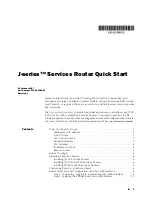
2.
Set the IP addresses of the built-in Ethernet ports. For example:
■
On a J2300 router:
root#
set interfaces fe-0/0/0 unit 0 family inet address 192.168.1.1/24
root#
set interfaces fe-0/0/1 unit 0 family inet address 192.168.2.1/24
■
On a J4350 or J6350 router:
root#
set interfaces ge-0/0/0 unit 0 family inet address 192.168.1.1/24
root#
set interfaces ge-0/0/1 unit 0 family inet address 192.168.2.1/24
root#
set interfaces ge-0/0/2 unit 0 family inet address 192.168.3.1/24
root#
set interfaces ge-0/0/3 unit 0 family inet address 192.168.4.1/24
The unit number is the logical interface number. IP addresses are configured on
the logical interface. Setting the protocol family to
inet
specifies the routing table
of IPv4 addresses.
3.
Set a default route (default gateway) for IPv4 packets. For example:
root#
set routing-options static route 192.168.1.254/24 next-hop 10.1.1.50
4.
Configure one or more static routes:
root#
set routing-options static route
destination-prefix
next-hop
address
5.
Set the hostname. For example:
root#
set system host-name Chicago
6.
Save your configuration settings and activate them on the Services Router:
root#
commit
For complete instructions, see the
J-series Services Router Basic LAN and WAN Access
Configuration Guide
.
J-Web Basics
The task bar at the top of the J-Web interface identifies the main J-Web functions.
You access specific tasks on the left.
■
Monitor—Output from common
show
commands
■
Configuration—Quick Configuration wizards and a graphical version of the CLI
■
Diagnose—Ping, traceroute, and packet capture
■
Manage—Configuration file management and licenses
■
Events—System log messages
■
Alarms—Active alarms
J-Web Basics
■
15
J-Web Basics


























